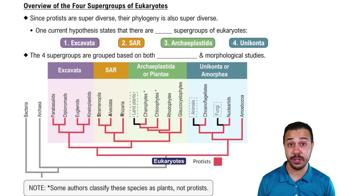Table of contents
- 1. Introduction to Biology2h 42m
- 2. Chemistry3h 40m
- 3. Water1h 26m
- 4. Biomolecules2h 23m
- 5. Cell Components2h 26m
- 6. The Membrane2h 31m
- 7. Energy and Metabolism2h 0m
- 8. Respiration2h 40m
- 9. Photosynthesis2h 49m
- 10. Cell Signaling59m
- 11. Cell Division2h 47m
- 12. Meiosis2h 0m
- 13. Mendelian Genetics4h 44m
- Introduction to Mendel's Experiments7m
- Genotype vs. Phenotype17m
- Punnett Squares13m
- Mendel's Experiments26m
- Mendel's Laws18m
- Monohybrid Crosses19m
- Test Crosses14m
- Dihybrid Crosses20m
- Punnett Square Probability26m
- Incomplete Dominance vs. Codominance20m
- Epistasis7m
- Non-Mendelian Genetics12m
- Pedigrees6m
- Autosomal Inheritance21m
- Sex-Linked Inheritance43m
- X-Inactivation9m
- 14. DNA Synthesis2h 27m
- 15. Gene Expression3h 20m
- 16. Regulation of Expression3h 31m
- Introduction to Regulation of Gene Expression13m
- Prokaryotic Gene Regulation via Operons27m
- The Lac Operon21m
- Glucose's Impact on Lac Operon25m
- The Trp Operon20m
- Review of the Lac Operon & Trp Operon11m
- Introduction to Eukaryotic Gene Regulation9m
- Eukaryotic Chromatin Modifications16m
- Eukaryotic Transcriptional Control22m
- Eukaryotic Post-Transcriptional Regulation28m
- Eukaryotic Post-Translational Regulation13m
- 17. Viruses37m
- 18. Biotechnology2h 58m
- 19. Genomics17m
- 20. Development1h 5m
- 21. Evolution3h 1m
- 22. Evolution of Populations3h 52m
- 23. Speciation1h 37m
- 24. History of Life on Earth2h 6m
- 25. Phylogeny2h 31m
- 26. Prokaryotes4h 59m
- 27. Protists1h 12m
- 28. Plants1h 22m
- 29. Fungi36m
- 30. Overview of Animals34m
- 31. Invertebrates1h 2m
- 32. Vertebrates50m
- 33. Plant Anatomy1h 3m
- 34. Vascular Plant Transport1h 2m
- 35. Soil37m
- 36. Plant Reproduction47m
- 37. Plant Sensation and Response1h 9m
- 38. Animal Form and Function1h 19m
- 39. Digestive System1h 10m
- 40. Circulatory System1h 57m
- 41. Immune System1h 12m
- 42. Osmoregulation and Excretion50m
- 43. Endocrine System1h 4m
- 44. Animal Reproduction1h 2m
- 45. Nervous System1h 55m
- 46. Sensory Systems46m
- 47. Muscle Systems23m
- 48. Ecology3h 11m
- Introduction to Ecology20m
- Biogeography14m
- Earth's Climate Patterns50m
- Introduction to Terrestrial Biomes10m
- Terrestrial Biomes: Near Equator13m
- Terrestrial Biomes: Temperate Regions10m
- Terrestrial Biomes: Northern Regions15m
- Introduction to Aquatic Biomes27m
- Freshwater Aquatic Biomes14m
- Marine Aquatic Biomes13m
- 49. Animal Behavior28m
- 50. Population Ecology3h 41m
- Introduction to Population Ecology28m
- Population Sampling Methods23m
- Life History12m
- Population Demography17m
- Factors Limiting Population Growth14m
- Introduction to Population Growth Models22m
- Linear Population Growth6m
- Exponential Population Growth29m
- Logistic Population Growth32m
- r/K Selection10m
- The Human Population22m
- 51. Community Ecology2h 46m
- Introduction to Community Ecology2m
- Introduction to Community Interactions9m
- Community Interactions: Competition (-/-)38m
- Community Interactions: Exploitation (+/-)23m
- Community Interactions: Mutualism (+/+) & Commensalism (+/0)9m
- Community Structure35m
- Community Dynamics26m
- Geographic Impact on Communities21m
- 52. Ecosystems2h 36m
- 53. Conservation Biology24m
28. Plants
Land Plants
Problem 1`
Textbook Question
Three of the following are evidence that charophytes are the closest algal relatives of plants. Select the exception.
a. Similar sperm structure
b. The presence of chloroplasts
c. Similarities in cell wall formation during cell division
d. Genetic similarities in chloroplasts
 Verified step by step guidance
Verified step by step guidance1
Understand the relationship between charophytes and plants. Charophytes are a group of green algae that share several characteristics with land plants, suggesting a close evolutionary relationship.
Identify the characteristics that are commonly used to establish evolutionary relationships. These include structural similarities, genetic similarities, and biochemical pathways.
Examine each option provided in the problem: a. similar sperm structure, b. the presence of chloroplasts, c. similarities in cell wall formation during cell division, d. genetic similarities in chloroplasts.
Consider which of these characteristics are shared specifically between charophytes and land plants, and which might be more broadly shared among other algae as well.
Determine the exception by identifying the characteristic that is not uniquely indicative of a close relationship between charophytes and land plants, but rather a common feature among many algae.
 Verified video answer for a similar problem:
Verified video answer for a similar problem:This video solution was recommended by our tutors as helpful for the problem above
Video duration:
3mPlay a video:
Was this helpful?
Key Concepts
Here are the essential concepts you must grasp in order to answer the question correctly.
Charophytes
Charophytes are a group of green algae considered the closest relatives to land plants. They share several key features with plants, such as similar reproductive structures and genetic traits, which provide evidence for their close evolutionary relationship. Understanding charophytes helps in studying the transition from aquatic to terrestrial life in plant evolution.
Recommended video:
Guided course

Overview of the Four Supergroups of Eukaryotes
Chloroplasts
Chloroplasts are organelles found in plant and algal cells responsible for photosynthesis. They contain chlorophyll, which captures light energy to convert carbon dioxide and water into glucose and oxygen. The presence of chloroplasts in both charophytes and plants suggests a common ancestry, highlighting their evolutionary connection.
Recommended video:
Guided course

Chloroplasts
Cell Wall Formation
Cell wall formation during cell division involves the construction of a new cell wall between dividing cells. In both charophytes and plants, this process shows similarities, such as the use of phragmoplasts, which are structures that guide the formation of the cell plate. These similarities indicate a shared evolutionary mechanism in cell division.
Recommended video:
Guided course

Introduction to Bacterial Cell Walls
Related Videos
Related Practice










